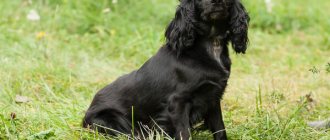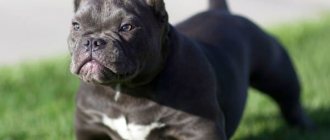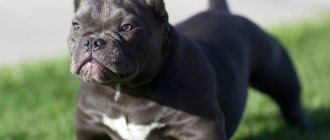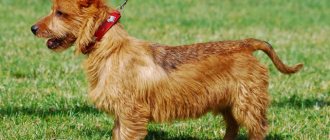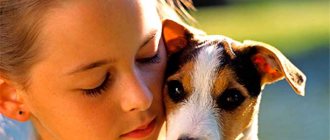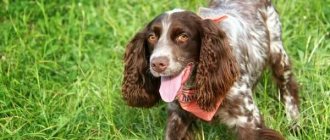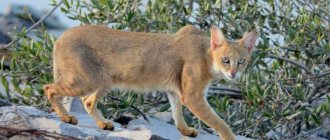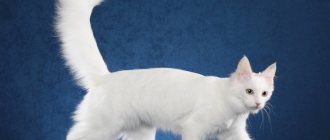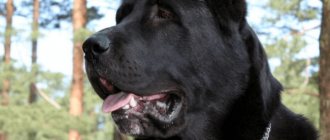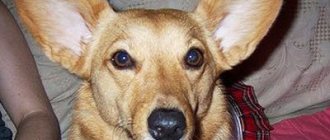Black pit bulls look strict and at the same time quite elegant.
These medium-sized, strong, muscular and hardy dogs are suitable for indoor living.
They are quite unpretentious in everyday life and do not require complex care.
Black pit bulls can make excellent family pets, but they are also good as sporting dogs, as well as participants in conformation shows held by organizations that officially recognize them.
Origin story and what it looks like in the photo
Dogs capable of fighting on equal terms with other animals, such as bears or lions, were highly valued even in ancient times . In particular, baiting dogs took part in fights with large predators in the arenas of ancient Roman amphitheaters.
It was these strong, hardy, persistent and brave dogs that became one of the ancestors of bulldogs, which in turn became the ancestors of bull and terriers. And from the latter all modern pit bulls originated.
Black color, like white , was very common in ancient times, therefore, already among the first pickling dogs there were many animals with jet-black hair .
It is not surprising that Molossians passed this coat color on to bulldogs, and they, in turn, passed on to bull and terriers, which became the ancestors of pit bulls.
Bear and bull baiting survived the Roman Empire and became a very popular pastime in Europe, including Britain. This continued until 1835, when a law was passed in England prohibiting such spectacles.
After this, Bull and Terriers began to be used as fighting dogs, pitting them against other dogs . Such fights were also very popular because they did not even require a special arena.
Subsequently, at the end of the 19th century, bull and terriers were brought to America, where, as a result of breeding work, pit bulls were bred, inheriting the best qualities of their ancestors.
Moreover, they were used not only for dog fighting, but also as hunting dogs, as well as guards and companions..
Leopard
leopard Albanian pit bull
Under the influence of the Merle phenomenon, the marbled coloration of spotted Albanian pit bulls occurred. Experts believe that this color should not exist and it is prohibited to breed animals with such hair. At the same time, the sale of puppies of this color is very popular abroad.
In the USA, as a result of crossing, a puppy of a unique merle color was obtained. By body structure it is a pit bull, and by the color of its coat it is a cheetah. The dog is named Titus. It has not yet been possible to repeat this achievement.
Marriage or breed?
Black color, as well as coat colors derived from it, are not among the two prohibited colors (merle and albinism), and therefore are standard for dogs of this breed.
Expert opinion
Kozhevin Semyon Kirillovich
Expert dog handler.
“The black pit bull terrier, despite its formidable appearance, with proper upbringing, grows into a calm, friendly dog, devoid of aggression towards people. True, the use of these dogs in the past as fighting dogs led to the development of innate intraspecific aggression in pit bulls, which is why black pit bulls need early socialization. The character of these dogs contains a mixture of many opposing qualities. And whether a black pit bull will grow up to be angry and aggressive or, on the contrary, affectionate and friendly towards people, depends only on its owner, on how much effort and time he spends on properly raising and training his pet.”
Fight today
Despite the ban on dog fighting in the United States and other countries around the world, it is still in demand . People make a lot of money in this business. The owners receive dividends from the illegal betting. It is difficult for animal rights activists to prove that the dog died in the ring and the courts are powerless to pass a verdict. The fine for organizing fights is minimal.
Until 1976, there was an official organization supporting the breeding of fighting dogs. Its founder was Guy McCordor. After his death, the association was headed by his daughter and she radically changed the course of work. It was then that active promotion of the breed as a companion began. Educational work went on on all fronts. Volunteers literally explained the importance of proper upbringing and that American pit bull terriers are not born killers. To legalize betting, the owner of the association proposed competitions in the transportation of heavy loads and exhibitions.
However, the pit bull breed needed fighting. For this purpose, a humane version of them was introduced. She was called contact. This is not the same bloodbath as before, this is a competition of strength. There is a set of serious rules and restrictions.
Character traits
Black pit bull terriers are distinguished by their strength and self-confidence, but at the same time they are quite cheerful, active and playful. These dogs are loyal to their owners and enthusiastically try to please them. However, like their terrier ancestors, they can be stubborn and willful from time to time.
Black pit bulls are genetically devoid of aggression towards humans, which is why any attempts to embitter these dogs or set them against people can lead to a mental breakdown and unpredictable behavior of the pet.
It is this lack of aggression towards people that makes pit bulls so popular as family dogs. These dogs are very good with children, however, given their contradictory nature, experts still do not recommend leaving children alone with such a pet.
Despite the fact that black pit bulls are friendly even towards strangers, it is quite possible to use them as guards, since these dogs will not allow anyone to encroach on the property of their adored owners.
Pit bulls have an extremely negative attitude towards other animals, in particular, other people’s dogs, since they were originally bred for baiting animals and for dog fighting, and therefore they are naturally characterized by zoo aggression.
Only with proper upbringing and early socialization is it possible to ensure that a representative of this breed is calm towards other dogs, as well as other living creatures.
Pit bull breed color loci
The pit bull, like other representatives of the canine world, has the same number of color loci - twelve in total. There is no breed of dog in which all 12 loci are present at the same time.
Pit bulls are no exception. Despite the presence of a wide palette of hair colors, representatives of the pit bull breed lack four loci:
No.LociExplanations
| 1. | M (merle) | Dominant color locus: all merle-colored individuals always have at least one merle parent. For example, Albanian pit bulls do not have this. |
| 2. | R | A state of recession of this locus causes albinism. Today, this locus is present only in Doberman Pinschers. |
| In pit bulls, total albinism can be found only occasionally: when the pigment is completely absent both in the coat and in the skin. | ||
| In such dogs, the surfaces of the nose and mucous membranes are flesh-colored, and the irises of the eyes are red or blue. | ||
| 3. | G | Progressive graying of the coat or age-related coloring. This is a dominant color: it is present in poodles, bobtails and other breeds. |
| Such puppies are born black or brown, changing color over time from child to adult. They “rebloom” into blue or isabella individuals. | ||
| 4. | R (roanity) | Is the dominant color. In a dominant form, it is found in breeds such as shorthaired pointers, drathaars, etc. |
| Rowaning is similar to speckling, but instead of small areas, only individual hairs of fur on a white background are pigmented. |
Color is the most important criterion when choosing a pit bull dog. The coat of pit bulls is characterized by heterogeneity, it consists of different types of hair:
- integumentary;
- guard;
- downy
Important! The color of the dog is transmitted through the guard hairs, and the shade is controlled by pigment. If there is a deficiency/absence of pigment, the wool looks colorless. Pit bulls have three main pigment colors: black, brown, yellow.
Pitbull fans should know that there is a special red-nosed line of dogs. Dog handlers classify her as a member of the so-called “old family” Old Family Red Nose.
All Red Nose Pit Bulls have a tan coat, coppery nose, lips, paw pads and rich brown eyes.
The color of the skin and coat is formed by a special pigment - melanin. In nature there are two varieties of it:
- eumelanin (this is black and brown colors);
- pheomelanin (yellow and orange colors).
The genotype of colored individuals is formed through various “gene sets”. The following genes are responsible for the color of a pit bull's coat:
- “C” – creates pigmentation of any color;
- “A” – spreads pigmentation throughout the hairline;
- “B” – creates a black color scheme;
- “c” – partial albinism;
- “b” – forms a brown pigment.
Representatives of this breed can have any eye color: it is not uncommon for a pit bull to have yellow, green, or even blue eyes.
Advantages and disadvantages
Pros:
- Strength, endurance, energy.
- Friendly attitude towards people.
- Intelligence, intelligence and fairly good learning ability.
- They get along well with children.
- Suitable for use as a sporting or hunting dog.
- They can successfully guard a house or apartment.
- Usually they are in good health.
- Unpretentious in maintenance and feeding.
Minuses:
- They need proper upbringing, as well as early socialization.
- You need to treat your pit bull kindly, but at the same time strictly.
- They are not suitable for constant outdoor living, as they freeze very much in winter.
- They do not like other animals and can be aggressive towards them.
- You cannot teach disciplines related to aggression towards a person, for example, detaining and escorting a violator.
- Sometimes they are very stubborn and headstrong.
Experts do not recommend purchasing black pit bulls as your first dog, since only a person who has already had experience in keeping other serious breeds can cope with such a pet and raise it correctly.
Is it true that this is a dangerous and aggressive breed?
The character of a dog depends on its upbringing and training. Of course, it cannot be said that you can behave with an American pit bull in the same way as with a small, designer breed. The zeal to fight for them is a genetic feature and an integral part.
However, the dog’s character is balanced, in some cases it is soft and calm. But if there is a reason to attack a person or another animal, he will do it with incredible cruelty, proving to be much more dangerous than many other breeds.
Only his relatives will be more aggressive - pit bull mastiffs, which are much larger and angrier than him.
Pit bull mastiff
Dimensions, weight and other distinctive features
- Height . Males - 46-53 cm. Females - 43-51 cm.
- Weight . Males - 16-27 kg. Females - 14-23 kg.
- Head . Proportional to the body, medium in size, resembling a rectangle in shape. The skull between the ears is quite wide and somewhat flattened. The jaws, especially the lower one, are well developed, powerful and strong.
- Muzzle . Almost square in shape, quite wide and voluminous.
- Ears . If left undocked, they are semi-erect or pink-shaped; if docked, then, as a rule, they are quite short and pointed to the tips.
- Eyes . Almond-shaped or oval, set fairly low and not too prominent. The preferred eye color is dark brown, but it can also be lighter, for example, amber.
- Neck . Slightly widening towards the shoulders, strong, lean and muscular.
- Shoulder blades . Quite wide apart and set obliquely, strong and muscular.
- Back . Short and moderately wide, slightly sloping towards the base of the tail.
- Rib cage . Not very wide, but at the same time of sufficient depth, with well-developed muscles and slightly convex ribs.
- Forelegs . Medium length, strong and parallel, set moderately wide.
- Hind limbs . Strong and muscular with well angulated hocks.
- Tail . Relatively short, set rather low. Usually it is lowered down, but when excited and during movement it rises to the line of the back.
- Wool . Short, moderately stiff, close-lying and shiny. There is no undercoat.
Pit bull color genetics: many nuances
The American Pit Bull Terrier has short hair with a hard, elastic, close-fitting outer layer of hair. There is no hair in the pit bull's belly area.
The muzzle, paws and ears are covered with “velor” fur, shorter than the guard hair. The pigmentation of a pit bull’s nose, lips, and irises varies, as does the color palette of the coat.
The dog's coat can be anything: the breed even allows random inclusions of white and colored spots.
Attention! People who want to buy an unusual-looking pit bull are not fully aware of the problems they may face in the future. There are colors (for example, merle) that are artificial for pit bulls and lead to congenital diseases and serious mental disorders.
Before purchasing a cute pit bull puppy, you should learn not only the history of the origin of the breed, its biometric characteristics, but also understand why, for example, buying a luxurious Albanian pit bull or a blue-eyed albino will entail many problems and difficulties.
Shades of black in pit bulls
- Black . The purest possible shade of jet black is desirable, and this coat color may also have small white markings, for example, in the form of a white tie or white fingertips.
- Black and white . On the main black background there are white markings, the total area of which occupies no more than 50%.
- Black and Tan . With this color on a black background there are markings in the form of tan marks of reddish, reddish or light brownish shades. The location of the spots is the same as, for example, on Rottweilers or Dobermans: above the eyes, on the muzzle, on the chest, lower legs and under the tail.
- Tricolor . Similar to black and tan, except that this color also has white markings.
- Brindle . This color appears almost black if there are few red stripes on a black background.
The dark gray color also sometimes looks almost black, but can be distinguished by a more or less pronounced bluish tint to the coat.
White
Such a pure color is very rare. More often you can see a white pit bull with multi-colored spots. If a dog does not have a black edging around the lips and eyes, and the nose is light rather than black, then its color is associated with the presence of the albinism gene. This color of dog coat is not allowed. In general, white pit bulls are less susceptible to genetic diseases. These are healthy, strong, protective animals.
Life expectancy and what diseases are they susceptible to?
The average lifespan of black pit bulls is 12-15 years.
These dogs are in good health, but may be susceptible to some diseases.:
- Allergy.
- Von Willebrand's disease.
- Dysplasia.
- Bloating or volvulus of the stomach and intestines.
- Hypothyroidism.
- Cutaneous hemangioma or histocytoma.
- Aortic stenosis.
Additional information about the breed
The pit bull has powerful jaws and a constant need to chew something. Old non-studded tires, special hard treats, and molded rubber balls are perfect for dogs to play with.
It is important to provide your dog with toys in a timely manner so that he does not switch to his home environment out of boredom. On top of that, pitas are very affectionate and cannot stand long separation from their family. Prolonged loneliness can have a detrimental effect on your pet's health and character.
Prolonged loneliness can have a detrimental effect on your pet's health and character.
Pit bulls do not have an undercoat, so it is important to protect the dog from drafts and to purchase insulating clothing for it during the winter cold. In addition, pitas do not like to sleep on the floor. A special dog bed or sofa will not be superfluous.
A special dog bed or sofa will not be superfluous.
Basic rules of care
The dog's coat should be brushed once a week with a short-haired dog brush. Black pit bulls are bathed infrequently, once every two months, but it would be better once every six months.
Moreover, during preparation for the exhibition, if the dog owner wants to make the color more intense, he can wash the pet with a special shampoo for dark-colored dogs.
The ears, eyes and teeth of a black pit bull should be regularly inspected and cleaned if dirty . To clean the ears, cotton swabs are usually used, for the eyes - cotton pads, and for the teeth - a brush and toothpaste for dogs.
Nails should be trimmed with nail clippers as they grow, although if the pit bull walks quite a lot on hard surfaces, he may not need this procedure.
CAREFULLY!
In winter, it is recommended to put on your pet an insulated overall before going for a walk, which protects the dog from hypothermia.
American Bully diet
For proper development and full health, representatives of the American Bully breed need good nutrition. If you don't pay enough attention to this aspect, you can create a lot of problems for your pet. The owner's responsibility in this matter should be at its best.
Whenever it comes to the nutrition of our little brothers, there are ardent supporters of industrial food and those who prefer to feed their pet exclusively natural food. It is high time to stop the debate on this topic by defining a balanced diet as the main criterion for feeding a pet.
Industrial feeds have undeniable advantages. They contain carefully selected nutrients, vitamins and microelements, all in the correct proportions and sufficient quantities. The owner who chooses this method of feeding will not have to use additional food additives. It is only necessary to provide your four-legged friend with a sufficient amount of fresh water, which a dog eating commercial food should always have free access to.
Food for American Bullies must be selected from the premium category. Their quality will allow you to avoid problems in the form of allergic reactions and other possible adverse consequences. In the matter of choosing the right industrial food for a particular dog, the help of a qualified specialist is very welcome.
If the choice is made in favor of a natural diet, then it should consist of dietary meat and a mixture of three main cereals - rice, buckwheat and millet. In this combination, your pet’s lunch will be the most complete. When preparing food, do not use salt or spices. This is the basis of the American Bully menu.
But it needs to be diversified with the following permitted and useful additions:
- Low-fat fermented milk products (2-3 times a week);
- Seasonal fruits and vegetables;
- Vegetable oil (one tablespoon per day);
There is, of course, a list of prohibited foods that should never appear in a pet’s bowl, regardless of age.
This is, first of all:
- Any food from the host's table;
- All types of sweets, especially chocolate;
- Potato;
- River fish in any form;
- Fatty, spicy and pickled foods;
- Whole milk;
- Citrus;
- Onion and garlic;
- Mushrooms.
From the age of weaning, American Bully puppies should be fed at least 5 times a day. Then gradually the number of meals decreases, and an adult one-year-old dog needs to be fed only twice a day - in the morning and in the evening. It should be borne in mind that American Bullies are prone to gaining excess weight, so food portions should be moderate, and daily exercise should be mandatory.
How to feed?
A black pit bull should be fed either a complete ready-made food of premium grade or higher, or high-quality, home-cooked food that is balanced in composition..
In this case, you need to remember that an active and energetic pit bull requires a lot of protein products, preferably meat or meat products.
You must add boiled or raw vegetables to them, as well as porridge from rice, buckwheat or oatmeal, fermented milk products and vitamin supplements.
Given the predisposition of these dogs to overeating, you should not overfeed your pet or allow him to beg for food near the master's table.
Choosing a puppy
The American Pit Bull Terrier is a rather controversial breed. Therefore, those who decide to choose her for themselves need to carefully approach the purchase of a puppy. He must be quite active, but at the same time balanced. It is strongly recommended that you contact a specialized kennel, because the owners who sell such dogs through advertisements may not be very conscientious.
What kind of parents the puppy had plays an important role. If the father or mother had hereditary diseases, and were also distinguished by aggressive behavior, it is recommended to refrain from purchasing. The pedigree is carefully studied, and if there are no complaints about it, you can look at the baby. The color of the fur, eyes and other external features of the future pet are selected at the discretion of the owner.
The main feature of pit bull puppies is their stunning appearance and cuteness. You should not opt for individuals with a large head, as this is not at all a sign of power. The back should be level, the joints should not be too fragile, and the feet should be placed correctly. Behavior is also important. An ideal pet should not be aggressive, shy or inactive. If you comply with all the conditions, there is a chance to get a healthy and smart dog, as well as a loyal friend.
See below for more information on the characteristics of this dog breed.
How to choose?
You should buy a black pibul from a nursery or from a reputable breeder. When choosing a puppy, you must first of all pay attention to the origin and health of its parents: they must come from healthy lines, have a stable psyche and good conformation.
NOTE!
If you need a pet for sports or exhibitions, then it is advisable that the father and mother of the future pet have the appropriate diplomas for victories in competitions or in exterior rings.
A good black pit bull puppy looks well-fed, has a shiny, smooth coat, shiny eyes, and clean ears, nose and skin.
Such a baby behaves confidently and at the same time kindly towards people, he is active, mobile and playful.
Small gray dog breeds
Smaller gray dog breeds may be either completely gray or have only gray as part of their coat pattern. The most common small gray dog breeds are:
Italian Greyhound
The smallest greyhound dog, the Italian Greyhound, typically does not exceed 5 kg in weight and 38 cm in height at the withers. This is a smart, sweet, affectionate, calm and very sensitive dog. They are wonderful companions for those who can spend enough time with them, both indoors and outdoors. Common colors in this breed other than gray include black, white or tan.
Yorkshire Terrier
The most common color of the Yorkshire Terrier is a coat that is not entirely gray. While they have a beautiful metallic gray coloring on their body parts, the rest is a beautiful fiery color. However, you can see examples of Yorkies in blue or silver gray. They are especially known for their beautiful long hair that can be cut in a variety of styles...
poodle
Like the Schnauzer, the Poodle comes in several different types, which are primarily determined by its size. All types of poodles can show gray in their fur pattern, although it will be in several different shades. Poodles of all types tend to be very strong-willed, well-behaved, responsive to play, and can be incredibly loving. They are also noted as one of the smartest dog breeds in the world, so they need a lot of games to learn...
Chinese Crested Dog
Another type of small gray dog is the Chinese Crested Dog. Although they are not a solid color, this is not related to the coat pattern. This breed is unique in our list of gray dogs because its coat is actually white and its fur is gray. Since they have no hair on most of their body, these parts are visible and give them a gray tint. Hairy parts usually cover its head, tail and legs. These pieces of skin are what gives them their tufted appearance.
beagle
Elegant, stylish and proportionate, the Whippet is an energetic, loving and responsive dog breed. All colors and combinations are accepted except merle patterns. Although they may seem like a calm dog, they need plenty of exercise and should ideally be allowed to run freely in a large yard.
Vaccinations
American Pit Bull Terrier puppies are vaccinated for the first time at the age of 2.5-3 months. Vaccination is carried out by injection, sometimes the medicine is administered through the digestive tract or by airborne droplets.
DHLP-P is a vaccine that protects your dog against the following diseases:
- hepatitis;
- plague;
- parahepatitis;
- leptospirosis;
- parvovirus enteritis.
A separate rabies vaccination is also provided. The American Pit Bull Terrier is vaccinated against Lyme disease, whooping cough and against parasites only after consultation with a veterinarian.
The drug is administered to absolutely healthy dogs, so the owner is required to observe his pet two weeks before vaccination. At this time, the pit bull should not communicate with other animals and strangers.
It is important to eliminate the risk of contracting a cold and ensure psychological stability. If all these measures are followed, then the risk of the vaccination coinciding with the incubation period of any disease will be eliminated.
Important! The dog is not vaccinated during the change of teeth!
It is advisable not to walk the puppies for several days after vaccination; they are taken outside only when their normal state of health is fully restored.
Preventive vaccination for puppies is carried out throughout the year, after which it is repeated according to the schedule prescribed by the leading veterinarian.
Training and education
The future owner must immediately make it clear to the dog that he is in charge, not she. Otherwise, difficulties will arise with upbringing. Human dominance does not mean that cruelty is required in treatment. All commands should be given in a calm but at the same time firm voice. Your student should not feel that you are angry with him or her.
Steel endurance
In raising a puppy and its socialization, the most important age is considered to be up to 16 weeks. During this period, the owner needs to pay a lot of attention to his pet. You need to play with him, caress him, stroke him. The rest of the household should behave similarly, demonstrating that the pit bull is a full member of the family. At this age, contacts with strangers are also important, which will help him perceive them as non-threatening. Do not limit the puppy’s movements around the house; he should get used to his surroundings and surroundings. If there are rooms in your home where you do not want your pit bull terrier to enter, close them first.
Walks in crowded places are no less important for the dog’s future socialization. Their result will be the understanding that the world around us is big and is not limited only to the owner’s house, and that there are many people living in this world who do not need to be afraid. Sometimes puppies try to show aggression. To curb such manifestations, at such moments the small dog is turned over on its back and held in this position for several seconds. Such manipulation awakens in his genetic memory the laws of the pack, according to which a position on the back means a subordinate position. Thus, the person shows that he is the owner of the dog.
American Pit Bull Terriers have a good, tenacious memory. Teach him not only standard commands, but also any other commands. But it is important to remember: when raising a puppy, be consistent. When creating a system of prohibitions, you must always adhere to it. If you ban one thing today and allow it tomorrow, you will only confuse your pet. The rest of the family must also adhere to the established rules - no one can lift the prohibitions.
American pit bull terrier wearing an American headscarf
Pitbulls are very playful, especially at an early age, so the learning process is most effective through play. It is necessary to ensure that the puppy fully obeys all commands. If he does everything correctly, he should be praised and given a treat. It happens that a puppy tries to use his teeth during play. In such cases, the owner must sharply command: “No!” – and stop studying immediately. Thus, he makes it clear to her that attempts to bite a person cause a cessation of communication, and the dog clearly learns this lesson. After such “incidents,” training can be resumed no earlier than 20 minutes later.
The workouts should not be stretched; 5 minutes is enough for one session. Before it starts, the puppy needs to be actively walked, which helps him concentrate on commands. If your dog refuses to do them the first time, you need to be patient and go back to the basics by repeating the previous training step. It is not forbidden to let your pet run around without a muzzle and a leash, but only if you are in the forest or in a fenced area. Before doing this, you need to make sure that there are no other dogs nearby.
Sometimes, during training, problems with obedience may arise that the owner cannot cope with on his own. In this case, you should seek help from specialists. Such episodes should not be ignored, because as your pet grows older, it will begin to behave as it pleases, thereby posing a potential threat to others.
Helpful advice: before buying a pit bull, weigh the pros and cons, evaluate your strengths and capabilities, whether they are enough to raise him. We should also not forget that representatives of this breed are very sensitive, and if quarrels and scandals occur in your family, this will certainly affect his character - he will become restless and prone to neuroses.
